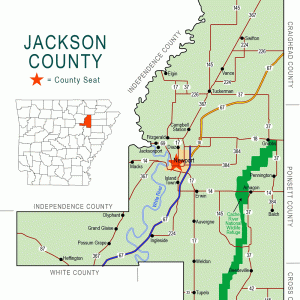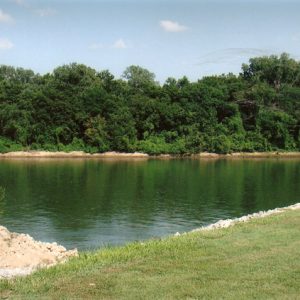calsfoundation@cals.org
Grand Glaise (Jackson County)
aka: Grand Glaize (Jackson County)
During its heyday in the 1850s, the river port town of Grand Glaise (Jackson County), located on one of the highest points on the banks of the White River, was one of the largest towns in the area. Before the Civil War, the town, located about ten miles downriver from present-day Newport (Jackson County), served as an area commercial hub.
The first white settler, Stith Tucker, arrived in the area in about 1817. By the late 1820s, a thriving river port named Grand Glaize had begun to develop. The first steamboat in the port, the Laurel, docked there in 1829. Further growth was prompted by the construction of a road in 1847 connecting the town to Searcy (White County). Several other roads were constructed within the next few years. By 1855, the state legislature authorized a toll road and bridge just south of the town.
The major contributor to the early development of the town was James H. Patterson, who in 1851 bought the town site. After Patterson sold a half interest to James Saffold, the two speculators had the town surveyed into streets, with Broadway being the town’s main thoroughfare. Soon, the town consisted of approximately seventy-five residences, two cotton gins, three stores, two saloons, four doctors, and a Methodist church that was established as part of the Grand Glaize circuit by 1856. A post office with Edwin B. Califf as postmaster was established in 1851. Some claim the population to have been around 1,500. The Freemasons established Byers Lodge No. 81 on November 9, 1854. A ferry across the White River was operated by Patterson starting in 1855; it remained in operation until 1876. The town was also incorporated in 1855, though its incorporation became inactive in 1865.
Patterson was also responsible for making the town a commercial center. He founded one of the early mercantile businesses and a packing house, which made the town a major market for cattle. A. P. Allen’s barrel factory was the town’s largest employer. The factory produced about 100 barrels a day shipped to Memphis, Tennessee; St. Louis, Missouri; and New Orleans, Louisiana.
By the outbreak of the Civil War in 1861, the town was growing rapidly, becoming the second largest in the county. A majority of locals supported the Confederacy, with many of the men enlisting in the Grand Glaize Rifles, which later became a company in the famous Seventh Arkansas Infantry. One suspected Unionist was imprisoned in a crate, which was addressed to President Abraham Lincoln and loaded onto a steamboat. The town’s war importance was due mainly to its location on the river, Patterson’s cattle packing house, and nearby salt licks. Opposing armies passed through the area on a regular basis, and many skirmishes were fought in the area. The nearest took place on June 27, 1862, when a Union forage train was driven back at the Skirmish at Stewart’s Plantation, approximately three miles to the north. Two Union expeditions came through the area in 1864, one of which destroyed the salt-manufacturing operations. The last Confederate forces in Arkansas surrendered at nearby Jacksonport (Jackson County) on June 5, 1865.
The town slowly began to recover after the war, but, with the declining river commerce, the future was uncertain. In 1869, the post office was briefly discontinued, and then it was permanently moved in 1874. The most severe blow came with the construction of the Cairo and Fulton Railroad. A survey had been completed by the late 1850s, but construction on the railroad did not pass near Grand Glaize until 1870. When completed, the tracks were some three miles to the west, bypassing the town for higher ground. Many began to move to the newly developing town of Bradford (White County).
In the 1890s, the town, now spelled “Grand Glaise,” saw brief prosperity with the discovery of freshwater pearls in the White River; even more profitable was the use of the mussel shells for buttons. Many locals made a living in the shell business until the market crashed in the 1930s. By 1935, only one general store and about 100 people remained. Excitement was generated in the area when, in 1937, the so-called White River Monster was sighted in the river near the town. In 1973, the legislature created the White River Monster Refuge extending between “the southern point on the river known as Old Grand Glaize and a northern point on White River known as Rosie.”
By the 1940s, another threat to the town’s survival was the construction of U.S. Highway 67. More people moved to the new transportation route, and the town continued a slow decline. By 1957, while the population remained steady, the only businesses that remained were two fish markets, a shell yard, and a movie theater. The shell industry saw a brief resurgence in the 1960s when Japanese companies began acquiring shells for use in the production of cultured pearls. Modern dredgers depleted the shells by 1970. By the 1990s, approximately forty people lived in the town, and the only public building was the Old Grand Glaise Missionary Baptist Church.
For additional information:
Kennedy, Steele T. “New Park in an Old Town.” Arkansas Democrat. April 12, 1959, pp. 3–4.
Lance, Charles. “River Rats Call It ‘Old Grand Glaise.’” Arkansas Democrat. July 4, 1957, p. 3.
Morgan, Sam. “A History of Grand Glaize.” Stream of History 28 (Summer 1991): 2–10.
Shiras, Tom. “Grand Old Glaise Was One of the Best Ports on Lower White Now Is Forgotten Village.” Arkansas Gazette. September 9, 1935.
Mike Polston
CALS Encyclopedia of Arkansas
 Jackson County Map
Jackson County Map  White River Monster Refuge
White River Monster Refuge 




I’m curious if anyone has information on Rev. William Elbert Mardis or his family. They are on my family tree. I have some old photographs that might be of interest to his family members. If interested, please state your connection to the Mardis family.
My great-grandfather and great-grandmother Mac and Lucy Pearl Parker owned the movie theater at the Glaise. They also had a tent movie theater that they would travel with throughout rural Arkansas during the Depression. Besides showing movies, Mac was a slack rope walker, magician, and sharpshooter. Lucy Pearl played the piano. All of the children helped with the show either running projectors or performing tricks. They even had a monkey! Their show was called the White River Entertainers. My grandmother was a contortionist, wriggling through little hoops. My great-uncle Henry Johnson had the last general store there.
I have lots of old playbills and photographs of the tent theater.
Sources: Betty Ann Rigg Stark (my mom) and my grandmother Oma Russain Parker Rigg.